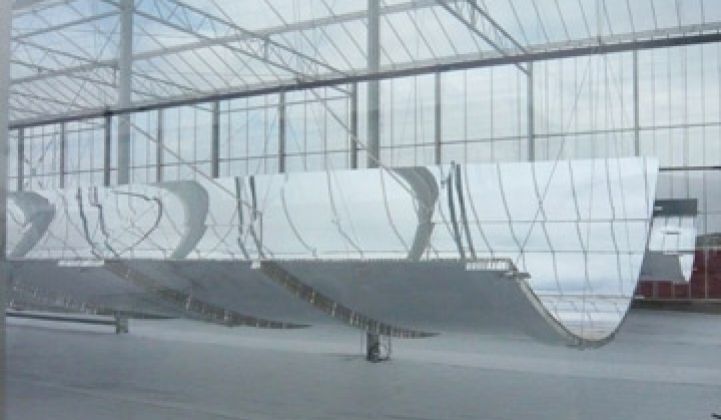When it comes to solar thermal power plants, GlassPoint is trying to think small.
The Fremont, California-based company has created a one-acre greenhouse filled with solar-energy collectors to create low-cost steam for an oil field. More, ideally, will follow.
BrightSource Energy is building a similar one for investor Chevron and Areva Solar has touted the benefits of solar steam in the past, too. The concept is straightforward: reflective surfaces help concentrate the sun’s heat, which then gets exploited to produce steam.
Solar thermal power plants produce steam as well, but they have to operate on a larger scale: BrightSource’s Ivanpah plant will produce 370 megawatts when built. Ivanpah and other large-scale plants, however, have drawn lawsuits and objections from environmental groups. Thermal power plants are also facing dire competition from ones based on solar panels. Hence, steam may be the way to go.
The project is expected to reduce the costs of producing steam, which will lower the price of oil and ensure jobs. “This is the first solar EOR (enhanced oil recovery) facility in the world and it was built without government money. Because all the easy oil has already been extracted, this is where the next generation [of oil recovery] takes off,” said U.S. Representative Kevin McCarthy, congressman for California’s 22nd congressional district, adding that this could also expand local employment.
During peak conditions, an acre of land will produce about 90 barrels of steam cheaper than the steam can be produced from gas. Gas is the largest component of any EOR operation and the solar unit will deliver energy for less than $3 per million BTUs.
Approximately 40% of the extracted oil in the state relies on natural gas. Theoretically, GlassPoint’s method could take over 80% of the burden. This will lower operating costs, said GlassPoint’s CEO Rod MacGregor:
”We are not going to oil companies saying, ‘This will save the planet.’ We say, ‘It would have helped you save the money.’ That’s a much more compelling proposition.” He also stressed that the construction was completed in just six weeks.
It could also recreate jobs, but how many and how you count them is up for debate.
"Each acre of solar field generates five jobs -- most of the elements needed were manufactured locally. Creating systems just for 20% of EOR energy would generate 25,000 jobs here," said MacGregor.
“It also saves jobs,” he added. “When you extract oil from the ground, it is depleted. Because California oil is heavier, it finally becomes unrecoverable. We have been pumping oil here for a century and all the easy oil is gone. If it cannot be extracted anymore, because the costs are higher, you’d lose the current jobs. This system gives the next generation use of the field and its oil, more cleanly and efficiently, so it expands job creation and keeps the current jobs, as well as creating new ones.”
Petroleum Development Oman (PDO) Corporate Technology Advisor Syham Bentouati has studied the effect of solar-generated steam on oil production. She said: “Solar-generated steam provides a viable alternative to constant-rate injection of steam derived from natural gas.”



